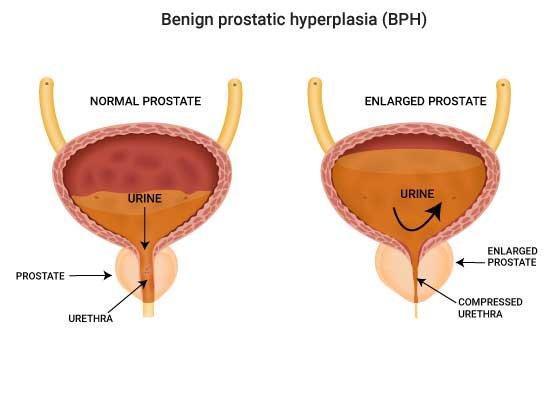Benign prostatic hyperplasia (BPH) is very common nowadays because it is a natural part of the aging process for many men. As men age, the levels of hormones such as testosterone in the body change, which can increase the prostate gland’s size. Additionally, other factors such as genetics, lifestyle, and medical conditions can contribute to the development of BPH. It is estimated that about 50% of men over the age of 50 and up to 90% of men over the age of 80 will experience symptoms of BPH. This high prevalence, combined with the aging of the global population, means that BPH will continue to be a common condition in the future.
What is Benign prostatic hyperplasia (BPH)?
Men can develop benign prostatic hyperplasia (BPH), a benign prostate gland enlargement. It commonly occurs with aging and can cause urinary symptoms such as frequent urination, weak urine flow, and difficulty starting and stopping urination. BPH is typically treated with medications or minimally invasive procedures; surgery may be necessary in severe cases.

Benign prostatic hyperplasia Symptoms
The symptoms of benign prostatic hyperplasia (BPH) are listed below:
- Difficulty starting urination
- Weak urine flow
- Dribbling after urination
- Urgency to urinate
- Frequent urination, especially at night
- Inability to empty the bladder
- Straining to urinate
- Interrupted or stopped urine stream
It’s crucial to remember that some of these symptoms could potentially be brought on by other illnesses. Hence, a proper evaluation by a healthcare provider is necessary for proper diagnosis and treatment.
Benign prostatic hyperplasia Causes
The exact cause of benign prostatic hyperplasia (BPH) is unknown, but several factors have been identified that may contribute to its development:
- Age: BPH is most common in men over the age of 50
- Hormonal changes: As men age, testosterone levels and other hormones in the body change, which can lead to prostate growth
- Genetics: BPH may be inherited and run in families
- Other medical conditions: Conditions such as obesity and metabolic syndrome have been linked to an increased risk of BPH
It’s important to note that BPH is not a cancerous condition and does not increase the risk of prostate cancer. However, if left untreated, BPH can lead to serious complications such as urinary tract infections, bladder stones, and in severe cases, complete urinary retention or kidney damage.
Diagnosis of Benign prostatic hyperplasia (BPH)
The diagnosis of benign prostatic hyperplasia (BPH) typically involves the following steps:
- Medical history: A healthcare provider will take a detailed history of your symptoms and past medical history
- Physical exam: A physical examination, including a digital rectal exam (DRE), to feel the size and shape of the prostate gland
- Urine tests: A urine test may be done to check for signs of an infection or other conditions that may cause similar symptoms
- Blood tests: Blood tests, such as a prostate-specific antigen (PSA) test, may be done to rule out prostate cancer problem.
- Imaging tests: Imaging tests, such as an ultrasound or MRI, may be done to get a better view of the prostate and surrounding tissues
- Urodynamic tests: Urodynamic tests, such as a uroflowmetry test, may be done to assess how well the bladder and urethra are working
Based on the results of these tests, a healthcare provider can diagnose BPH and determine the best course of treatment. In some cases, a prostate biopsy may be necessary to rule out prostate cancer.
Benign prostatic hyperplasia Treatment
Treatment options for benign prostatic hyperplasia (BPH) depend on the severity of symptoms and may include the following:
- Medications: Alpha-blockers, 5-alpha reductase inhibitors, and combinations of these medications can help relax the prostate and improve urinary cancer symptoms
- Minimally invasive procedures: Procedures such as transurethral microwave therapy (TUMT) or transurethral needle ablation (TUNA) can help shrink the prostate and improve urinary symptoms
- Surgery: In severe cases, surgery such as transurethral resection of the prostate (TURP) or laser therapy may be necessary to remove part of the prostate and relieve symptoms
- Watchful waiting: In some cases, especially in older men or those with mild symptoms, a wait-and-see approach may be appropriate, and medications may be prescribed as needed
Working with a healthcare provider to determine the best treatment option for your situation is important. To correctly manage symptoms, a mix of therapies may occasionally be required.
Call To Action
It’s crucial to find a healthcare provider with whom you feel comfortable and who has experience treating benign prostatic hyperplasia (BPH) and other urologic conditions. If you’re looking for one, your search is over right now! Dr. Saket Narnoli provides the best urology services to patients with urology problems. Dr. Saket Narnoli’s motto is patient satisfaction is a must.






